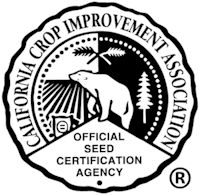(Artemisia spp.)
GENERAL STANDARDS -- The standards on this sheet are in part condensed and apply to Sagebrush species. For greater detail and additional provisions, see the Native Seed Program Standards.
APPLICATION -- Applications should be submitted electronically on CCIA’s website (Application to grow and certify seed) as soon as possible and no later than three (3) weeks after planting. New applicants should contact the CCIA office for instructions on obtaining access to the online application system. Applications for G0 collections must be submitted two (2) weeks prior to seed collection.
FIELD HISTORY -- Field history requirements do not apply to G0 collections. For G1-G10 production, land must have no prior Artemisia species production for at least 2 years. Sagebrush must be planted in distinct rows. Exceptions must be approved by the Seed Certification Office prior to planting.
ISOLATION -- Seed fields must be isolated from other native seed selections, varieties, or wild populations of Artemisia spp. by the following distances*:
| Factor | G0 | G1 | G2 | G3 | G4 to G10 |
| Less than 5 acres | N/A | 900 feet | 450 feet | 330 feet | 165 feet |
| More than 5 acres | N/A | 600 feet | 303 feet | 165 feet | 165 feet |
*A seed field located within the same geographic source area as was identified for the native seed being increased does not require isolation from naturally occurring plants of the same species adjacent to the seed field.
FIELD INSPECTION -- Include a seedling and a seed crop inspection. G0 collection site inspections may take place prior to, during, or after collection.
Off-Types -- Every field should be rogued to remove any plants of another crop or variety, including volunteers. Native seed selections cannot always be differentiated at field inspection. When differences can be distinguished, the maximum mixture of other varieties or definite off-types permitted is as follows:
| Factor | G0 | G1 | G2 | G3 to G10 |
| Other varieties & off-types | N/A* | 1:1,000 | 1:500 | 1:250 |
| Other kinds (inseparable other species) | N/A* | 1:2,000 | 1:1,000 | 1:500 |
*Individuals collecting G0 seed must be knowledgeable in their ability to distinguish Artemisia species.
Weeds -- Fields (G1-G10) must be free of any noxious weeds with a prohibited seed rating. Noxious weeds with a restricted seed rating and common weeds difficult to separate must be controlled. Noxious weeds with Prohibited and Restricted seed ratings are listed in the California Seed Law/CA Code of Regulations/Sections 3854 and 3855. See California Seed Law - Prohibited and Restricted Noxious Weed List. Individuals collecting G0 seed must be knowledgeable in their ability to identify noxious weeds with prohibited and restricted seed ratings that are common present in the collection area.
Fields may be refused certification due to unsatisfactory appearance caused by weeds, poor growth, poor stand, disease, insect damage, and any other condition that prevents accurate inspection or creates doubt as to identity of the native seed entity.
SEED STANDARDS – Minimum Sample Size – 24 grams*
| Factor | G0 | G1 | G2 | G3 to G10 |
| Pure Seed (Minimum)* | 10% | 10% | 10% | 10% |
| Inert Matter(Maximum)* | 90% | 90% | 90% | 90% |
| Off-types (same species) (Maximum) | 0.25% | 0.25% | 0.50% | 0.75% |
| Other Crop (Maximum) | 0.5% | 0.5% | 0.5% | 0.5% |
| Weed Seed (Maximum) | 0.5% | 0.5% | 0.5% | 0.5% |
| Noxious Weed | None | None | None | None |
| Germination + Dormant Seed or TZ (Minimum)* | 50% | 50% | 50% | 50% |
*For Artemisia ludoviciana and all subspecies, sample size (min.) is 6 grams, pure seed (min.) is 20%, inert matter (max.) is 80%, and germination + dormant or TZ (min.) is 30%.
Updated: May 2024
